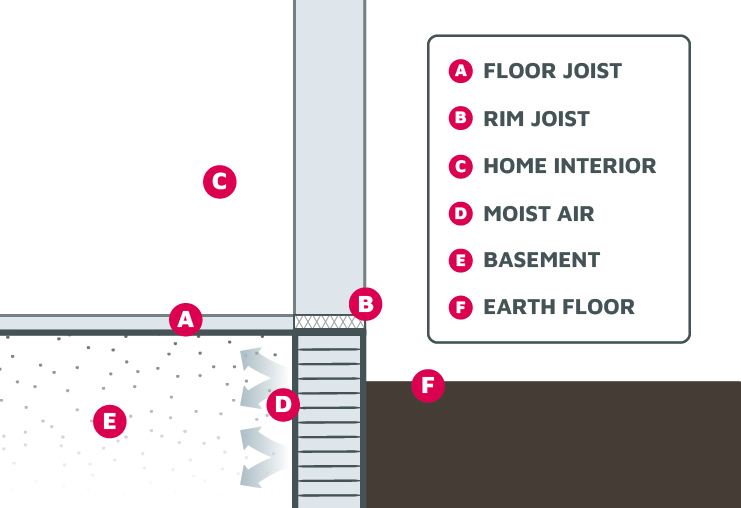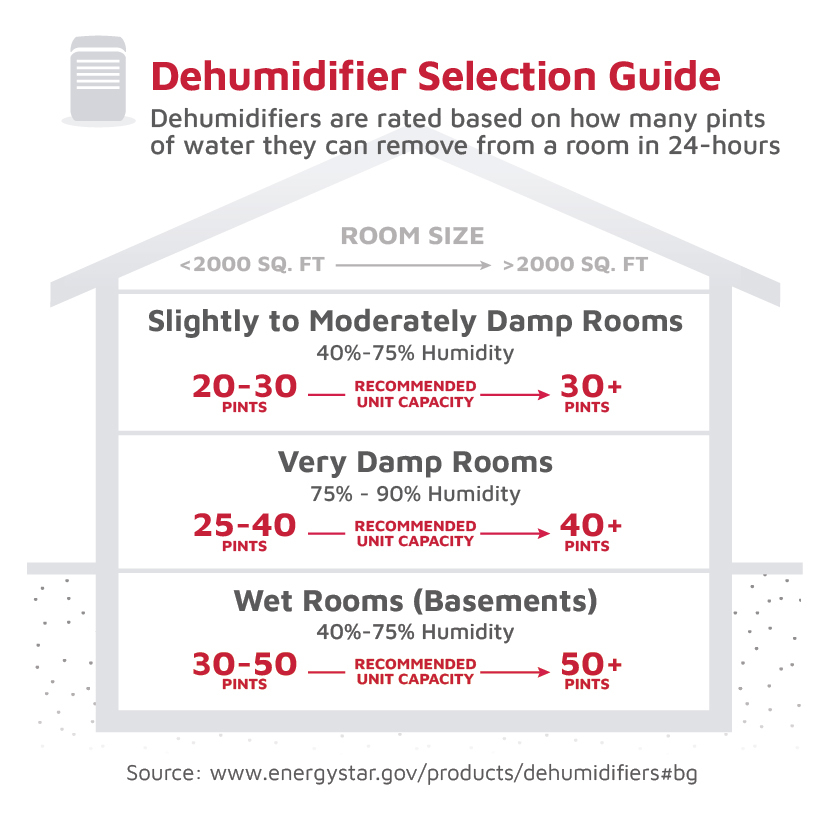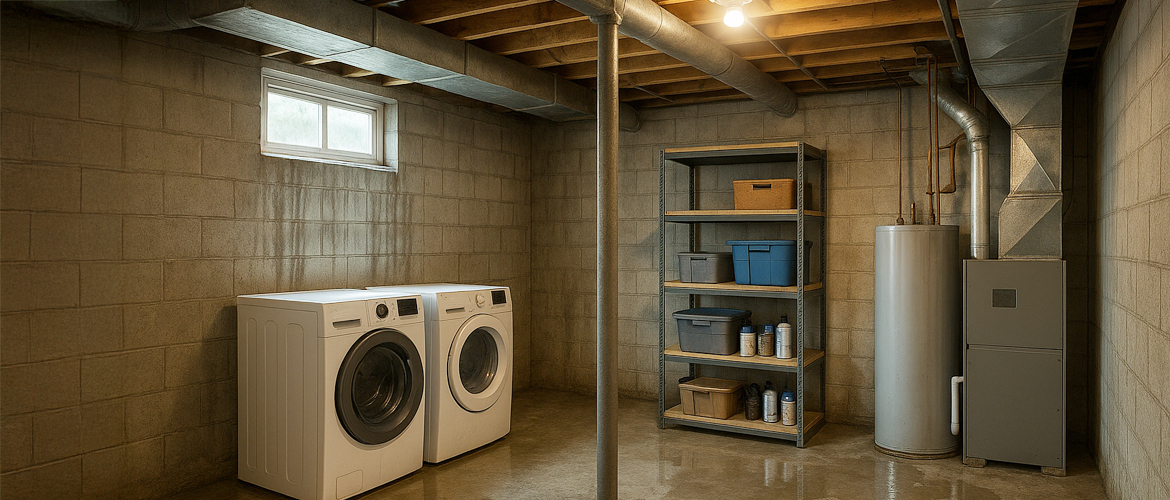Essential Tips and Techniques
While the relative humidity of the air surrounding your home typically ranges from 30% to 50%, the soil surrounding your basement is effectively 100% humidity year round.
Because basements sit below grade, they’re naturally prone to dampness, poor airflow, and seepage from surrounding soil. What feels like a minor issue—a damp smell or slight condensation on walls—can quickly escalate into mold growth, structural damage, or compromised air quality throughout the home.
As the seasons change, maintaining a comfortable and healthy home environment becomes a priority for many homeowners. One area that often requires special attention is the basement. Dehumidifying your basement is not just about comfort; it’s about safeguarding your property and your family’s health.
This guide explores why basements are especially prone to humidity problems, the risks that come with excess moisture, and the practical steps you can take to keep your basement dry and safe.
Understanding Basement Humidity
Basements are uniquely vulnerable to humidity because of their location below ground level. The soil that surrounds foundation walls is often saturated with water, especially after rainfall, and basements naturally have less ventilation than upper floors.

Common causes of humidity in basements
- Poor ventilation – Limited airflow traps moist air and prevents it from drying out.
- Groundwater seepage – Water can seep through foundation walls or floors, especially during heavy rains or if exterior drainage is inadequate.
- Leaky pipes or appliances – Small plumbing leaks or water heater issues can add a surprising amount of moisture over time.
The impact of high humidity on health and property
Unchecked basement humidity can create a cascade of problems.
- Mold growth – Mold thrives in damp, dark areas. Once established, it can trigger respiratory problems, allergies, and worsen asthma.
- Structural damage – Persistent moisture can weaken wooden framing, corrode metal supports, and erode foundation materials.
- Damage to belongings – Stored furniture, clothing, books, and electronics can warp, rust, or develop mold and mildew.
Ideal basement humidity level
Experts recommend maintaining whole home humidity between 30% and 50%. This range helps prevent mold growth, preserves your belongings, and protects the integrity of your home’s foundation.
How to Identify Excess Humidity in Your Basement
Recognizing the early warning signs of excess moisture is the first step toward addressing it.
- Musty odors – A persistent damp smell often signals mold or mildew activity.
- Visible mold – Dark spots on walls, floors, ceilings, or stored items are a clear indicator.
- Condensation – Water droplets forming on windows, pipes, or walls suggest the air is holding too much moisture.
These signs don’t just affect comfort—they also point to compromised indoor air quality. Air from the basement circulates into upper floors, meaning basement humidity can affect the entire home.
If you notice persistent problems, especially visible mold or structural concerns, it’s wise to seek professional help. HVAC and building specialists can diagnose the root cause—whether it’s a drainage issue, foundation crack, or undersized dehumidifier—and recommend lasting solutions.
Choosing the Right Dehumidifier for Your Basement
Not all dehumidifiers are created equal. The right unit can make the difference between a perpetually damp space and a consistently comfortable one.
Factors to consider
- Capacity – Match the unit to your basement size. Larger basements or those with severe moisture issues require higher-capacity units.
- Energy efficiency – Look for ENERGY STAR®-rated models to reduce operating costs while keeping humidity in check.
- Features – Useful options include automatic shut-off, continuous drainage connections, built-in humidistats, and digital humidity displays.
We recommend contacting an HVAC professional to help you find the best dehumidification solution for your space.
The benefits of energy-efficient models
Energy-efficient dehumidifiers are designed to remove excess moisture while using less power. Over time, they reduce utility costs and lessen environmental impact without compromising performance.

How to size a dehumidifier for your basement
- Small to medium basements (500 - 1,500 sq. ft.): A unit rated for 30–50 pints per day is often sufficient.
- Large basements (1,500+ sq. ft. or very damp conditions): Consider 70+ pint units or even whole-home dehumidification systems integrated with your HVAC equipment.
Best Practices for Dehumidifying Your Basement
Even the best equipment requires proper use and upkeep to deliver results.
- Set optimal humidity – Aim for 40–50% relative humidity on your dehumidifier. Avoid setting it too low, which can dry out materials unnecessarily.
- Placement matters – Position the unit in a central, unobstructed location for maximum airflow. If your basement has multiple sections, you may need more than one unit.
- Keep up with maintenance – Clean filters, check drainage hoses, and inspect for leaks regularly. A clogged filter or blocked drain line can reduce efficiency and allow moisture to return.
Additional Strategies to Control Basement Humidity
While a dehumidifier is often the centerpiece of moisture control, combining it with other strategies yields the best results.
- Improving ventilation – Use fans, vents, or even an air exchanger to keep fresh air circulating.
- Sealing and waterproofing – Repair foundation cracks, install sump pumps, or apply waterproof coatings to basement walls to reduce seepage.
- Insulating pipes – Wrapping cold water pipes prevents condensation that can drip onto floors or walls.
- Adding air purification systems – These can help filter airborne mold spores and pollutants, improving air quality while supporting dehumidification efforts.
A Healthier, Safer Home Starts Below Ground
Because basements are tucked away, it’s easy to ignore a damp smell or small patch of mold. But moisture issues don’t stay confined; they move upward, affecting your living spaces and potentially your health. Taking steps to manage basement humidity protects more than just a storage area—it preserves the integrity of your entire home and the comfort of everyone in it.
By identifying warning signs early, investing in the right dehumidifier, and pairing it with smart ventilation and waterproofing strategies, you can transform a damp basement into a dry, healthy extension of your living space.
If you’re experiencing any of the issues we discussed or would simply like to dial in the humidity level of your basement, set up an assessment with a local Lennox pro. They’ll help you find the equipment you need to keep your home comfortable and dry.

